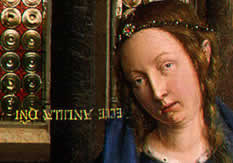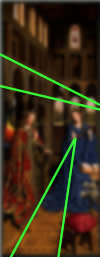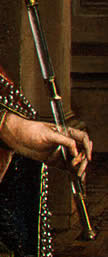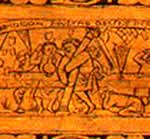
Month: March 2004
More info about the Van Eyck Annunciation
Some more details about the
Annunciation painting posted last week, which was painted by Jan van Eyck
around 1434-36.
 |
||
|
ECCE ANCILLA D[OMI]NI |
||
|
|
SCENES OF HEROISM The floor has illustrations of one man doing great things (in this case, |
|
 |
COMPLEX COMPOSITION The composition uses two perspectives: the foreground objects have a |
|
|
|
THE TRINITY God the Father appears in the stained-glass window at the top, God the |
|
 |
INTRICATE DETAILS At left, see how the crystal of Gabriel’s scepter is translucent, allowing |
|
|
THE MOST ASTONISHING DETAIL The painting is only a little over a foot wide and slightly less than The congregation would have been too far away to see any fine details More information about the painting is at the National |
||
And…
Formation… It sounds so proper!
Why can’t be just educate people through formation instead of having the Vatican issue “repressive” documents about liturgical abuse.
Fact is: the document on liturgical abuse is meant to be used in formation. It addresses the dos and don’ts in areas where some people who have in the past been responsible for formation have failed.
People who are on the CreativeLiturgy™ Bandwagon – take heed! No more stones instead of bread. Stop adding a few tablespoons of yourself into your liturgical activity and pay attention to hundreds of years of standard practice and to the actual text of the Vatican II documents instead of the Voice of Vatican II that you hear in your head.
Seriously. I’ve had it and skulls will be cracked if you don’t pay attention.
Follow-up
I’m looking forward to the Vatican document on Liturgical abuse in the same way I look forward to a constitutional amendment that affirms marriage is between a man and a woman.
What’s the correlation?
It’s the in both cases, the “informed professionals” have sought to impose norms that are counter to what the average person knows to be true.
If you see a nun in a leotard prancing about the sanctuary during the 1st reading, the average person knows that’s wrong.
When mayors are “marrying” same-sex couples, the average person knows that wrong, that it’s not a marriage but rather a farce and a political statement.
So the idea that guidelines on liturgical abuse could be “repressive” is quite outrageous. If the liturgists who brought us the Mass of the Unordained Women or the Dance of the Winter Solstice had repressed their own desire to remake the liturgy in their own image, we wouldn’t need the document.
People are longing for truth and a prayerful liturgical atmosphere. I’m sure the guidelines will help with that in as much as the Do-it-yourself-Liturgists can bring themselves to obey them.


